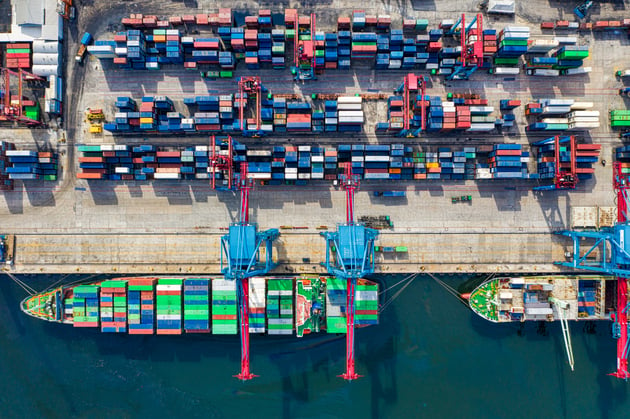Supply Chain Strain Breeds Innovation: 2022 Predictions
2021 — on the heels of such a momentous prior year — has yielded global conditions that strike a fever pitch in tone. The storylines that continue to weave and unfold include a cast of dominant characters: Covid-19, the climate change crisis, remote work, TikTok algorithms, ESG (environmental, social and governance), supply chain disruptions, microchip shortages, NFTs (non-fungible tokens) and the list goes on.
What the events have in common is a pressing call for greater disruption — well, maybe not the TikTok algorithms. The way things have always been done is no longer sufficient. As we head into the next calendar year with global economic recovery top of mind, let’s take a look at predictions for how technology will bring about certain changes to our status quo:
Supply Chain Innovation Will Receive Boost from Governments
International trade has recovered faster than supply chains are fit to handle. Nations have already begun testing the use of technologies such as blockchain to reduce the excessive time and resources required to maintain an accurate, secure paper trail of provenance (who has what, when and where). As governments around the world face a long road ahead moving toward economic recovery, much of the red tape historically involved in public-sector technology adoption will be removed with the prospects of boosting gross domestic product (GDP).
Blockchain Will Emerge from Crypto’s Shadow
The first thing people think of when hearing blockchain is crypto. At its core, blockchain is nothing more than a digital ledger providing an electronic paper trail of all transactions and the auditable data involved on the network. Those transactions do not need to be that of tokenized currency. The benefit of blockchain in moving out of the crypto/token/mining hype is in its ability to supply an immutable record of events and services that will increasingly be realized in use cases like secure medical data sharing, personal and corporate identity security, smart contracts across supply chain and logistics, and beyond into other industrial sectors.
Emissions Tracking Will Go Digital
Within the next 12 months, the cost of accurate reporting will emerge as the greatest obstacle to realizing carbon net-zero goals. An essential step to a carbon net-zero future is being taken with the formation of a new International Sustainability Standards Board (ISSB) to develop a comprehensive global baseline of sustainability disclosure standards. Despite trillions being promised at COP26, governments and private sector organizations will realize that the cost of accurate reporting will be the greatest barrier to meeting Glasgow Climate Pact targets. Current, manual practices for tracking Scope 1, 2 and 3 emissions cannot scale to meet required levels for accurate reporting and need to be conducted more frequently than once a year and with much greater accuracy — which is an extremely time- and resource-intensive process.
B2B Contracts Get An Overhaul
In 2021, the soaring cost of raw materials, bulk commodities, shipping and persistent supply chain delays fueled regular disputes between B2B counterparties over how to account for cost inflation and delivery shortfalls. Buyers have long been afforded the luxury of entering bill-on-consumption models in B2C agreements as opposed to bill-on-fill or delivery — significantly lowering the risk of supply chain uncertainty. This continued uncertainty entering the new year will drive the adoption of bill-on-consumption agreements for bulk commodities between B2B counterparties. To put it simply, it will be out with bill-on-fill and in with the traditional B2C model of bill-on-consumption in B2B agreements.
Smart Contract Networks Go Mainstream
Smart contracts are simply the digital representation of the commercial terms of a legal contract. As with legal contracts, there is only so much fun you can have with a smart contract without a participating counterparty. Assuming that counterparties use a consistent smart contract infrastructure, then a network of interconnected companies can evolve. The natural consequence of this is that the network offers increased functionality, and in tandem, the increased functionality attracts a greater number of participants delivering more value through the network. 2022 will be the year when these smart contract networks start to seriously proliferate.
Private Sector Information Sharing Networks Will Be Pivotal To U.S. Supply Chain Recovery
In the U.S., the goods movement chain is predominantly privately owned and operated. The White House recognized in its recent action plan that shipping lines, railroads, truckers, warehouses and beneficial cargo owners have “made great strides in digitizing their own internal operations, but they do not always exchange data with each other” and that “this lack of data exchange causes delays and inefficiencies as cargo moves from one part of the supply chain to another, driving up costs and increasing fragility.” In the coming year, we will increasingly see the public sector incentivize the formation of private sector networks and digital systems that enable secure, open data sharing between various parties to provide transparency in the commodity custody timeline and streamline operations.
No Holds Barred
Predictions can be a funny venture because they force a weighing of current events with a marriage to that which cannot be known. The only certainty is that change is in the cards. As the consequences of the last 24 months continue to reconfigure international business protocols and supply chain operations, technology and the severity and speed of its adoption will forever be reliant on the demand to solve current problems. Like a game of whack-a-mole, today’s complex environment forges new innovative solutions, which, in turn, reveal new issues...and so around we go into 2022.
This article, authored by Andrew Bruce, originally appeared at Forbes Technology Council.



